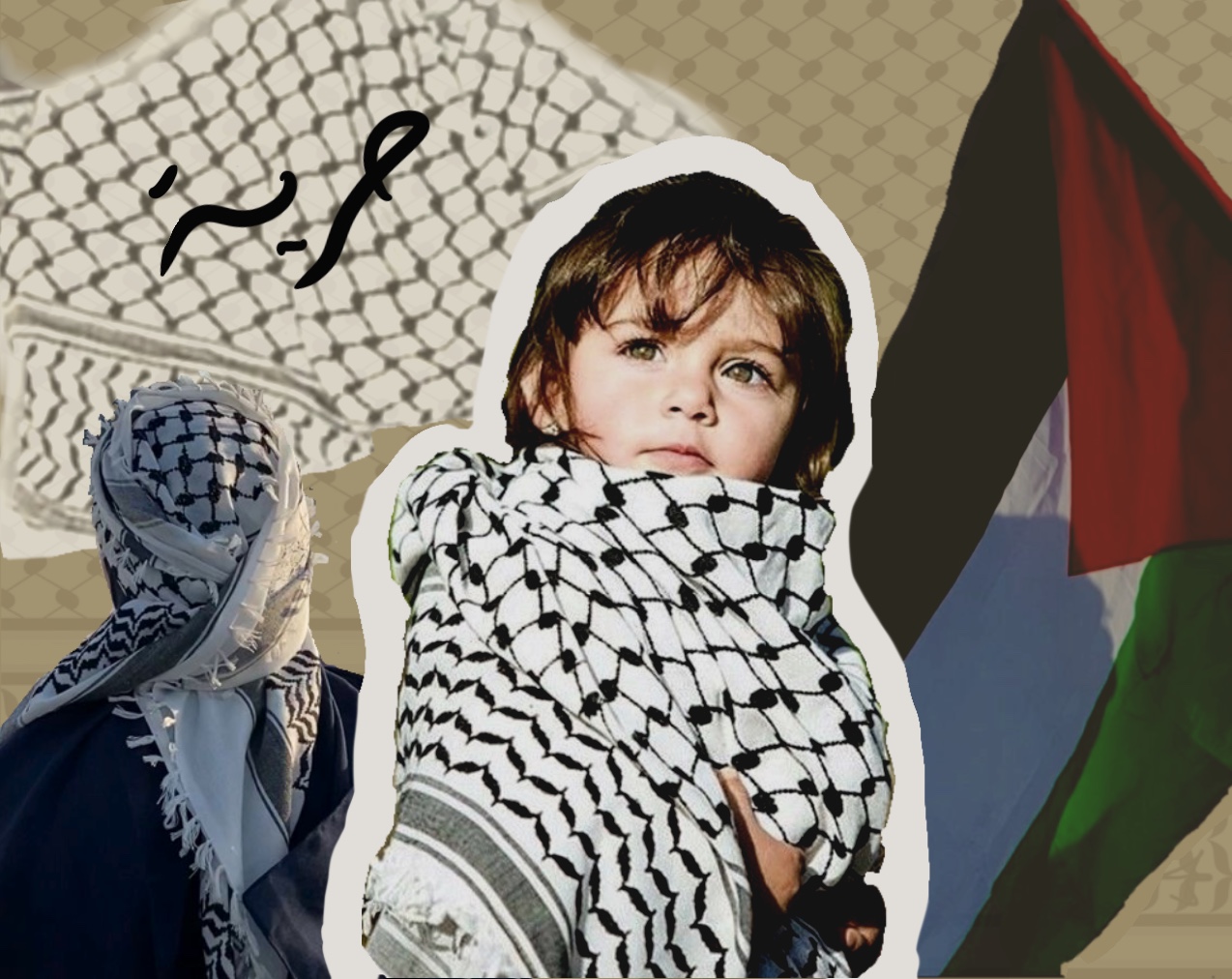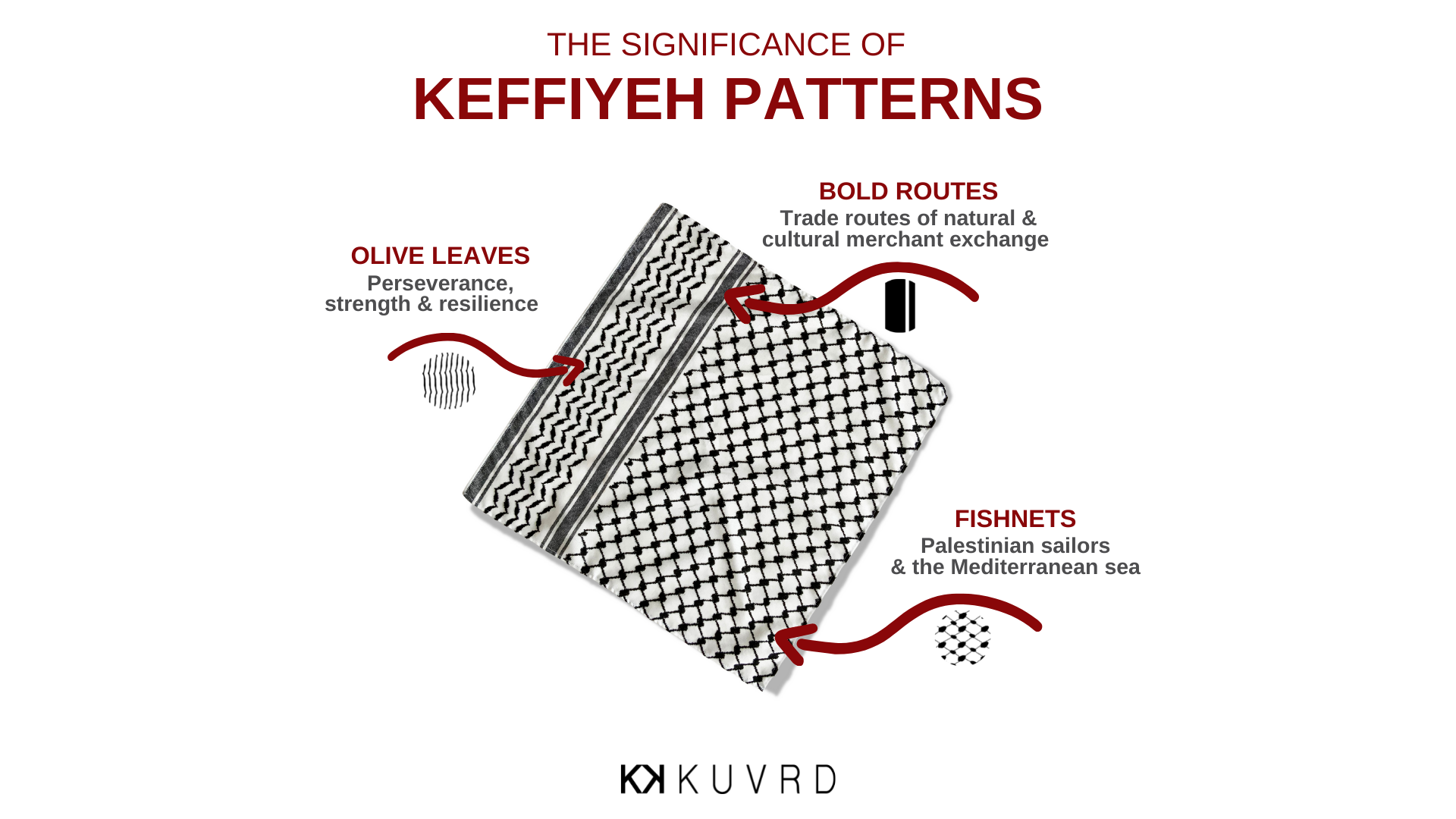AUTHOR: Jennah Faruqui
GRAPHIC DESIGNER: Ola Omar
COPY EDITORS: Janne Boecker, Jacob Marion
These have been profoundly hard days. First, the horrible massacre of civilians in Israel. Followed by the devastating bombardment and massive suffering of the Palestinians in Gaza, compounding the misery of the long, ongoing occupation.
As I walked through campus, to see students draping keffiyehs over their shoulders as a symbol of solidarity alongside the people and children of Palestine, I became interested in the complex conversations surrounding the keffiyeh as a powerful form of agency in the face of Palestine’s occupation. I wondered about the sociopolitical construct of a piece of cloth that amplifies a crowd’s cries for freedom.
I discovered that the hidden history of the keffiyeh goes far deeper as a unifying force inherent to the human experience. The keffiyeh uses fashion as an instrument to facilitate human connection. At the same time, it emphasizes the resilience of Palestinian cultural identity and ongoing history, offering itself as a map of the land of Palestine.
A keffiyeh is a square-shaped black and white chequered scarf traditionally folded diagonally and often fashioned around one’s neck, wrapped around one’s head or draped across the shoulders. The word “keffiyeh” is derived from the word “Kufa,” which is translated to “the city of Kufa” in Iraq. Origins of the scarf date back to elite classes of the Sumerian priests and Babylonians in West Asia within Mesopotamia in 3100 BC. Made from silk, wool, or cotton blends, the keffiyeh was a head covering eventually adopted by Arab men of the working class.
The notions of the cloth can be traced back to the Bedouins, a group of desert dwellers known to be the oldest inhabitants of the Arabian desert, honoured for their resourcefulness and hospitality. However, the Bedouin people lived in harsh climates; thus, they used the keffiyeh to shield and protect them from the summer sun, sand storms, the winter rain and cold. The keffiyeh’s breathability was engineered through air pockets moulded by the folds in the fabric. These folds reveal the patterned design and feature white tassels that elegantly move with each step.
The city of Jerusalem is holy to the Abrahamic religions—Judaism, Christianity and Islam. The keffiyeh does not have an established religious significance and predates Islam. Arab Christians, Muslims, Druze, and secular Arabs have all adorned the keffiyeh, allowing it to become an osmotic symbol in taking on new meanings and contexts.
The Arab Revolt against the British in 1936 became a pivotal moment in history, transforming the keffiyeh into a revolutionary symbol of resistance. Palestinian rebels would envelop their faces within the keffiyeh to hide their identity, preventing arrest from authorities. Consequently, the British banned the keffiyeh, and all Palestinians, in defiance, veiled themselves in keffiyehs, making it virtually impossible for the British to identify them.
Over the years of Jewish immigration to Palestine, the slogan “A land without people, for a people without land” suggested that Palestinians, native to the land for generations, did not have rights or ties to the “land.” The designs woven into the keffiyeh consist of patterns that convey Palestinian ties to their land: fishnets, bold routes, sea waves, and olive leaves. The most prominent feature of the keffiyeh resembles a fishnet, encompassing most of the scarf. This design pays homage to Palestinian fishermen and the sea. Secondly, the double-lined bold routes represent the various trade routes throughout Palestine; mapping the diverse culture and history through merchant exchanges.
Thirdly, the wave pattern illustrates sea waves and olive leaves, resembling the Palestinian people’s strength, perseverance, and resilience after 75 years of oppression and occupation. Olive trees, a symbol of peace, have long been an integral part of Palestine’s natural agriculture, deeply rooted in the Palestinian’s connection to their homeland. The olive tree, faithful to the land of Palestine, can survive and endure in a land where water is scarce, drawing equivalent parallels to the resilience of occupied Palestinian people. As the olive tree grounds itself in contempt of the surrounding climate, Palestinian civilians will continue to remain resilient in their land despite adversity.
For the last 75 years, Palestinian people have been oppressed within their own homeland. The occupation of Palestinians not only restricts freedom and infringes on human rights, but breaches international humanitarian law. Although the keffiyeh was initially primarily a representation of cultural identity and masculinity among Arab men, the keffiyeh spilled all over the world as men and women began to wear it. Inaugurating it as a symbol for all and encouraging unity against the Palestinian struggle.
Outside of the Middle East, the keffiyeh has also been a source of contention within the fashion industry while being a victim of cultural appropriation. Large fashion corporations have often capitalized off the keffiyeh pattern without acknowledging its historical significance or the Palestinian struggle for freedom. U.S. fast fashion retailer Urban Outfitters channelled the popularity of the keffiyeh, selling an inauthentic version labelled “anti-war woven scarf” to be displayed ubiquitously in the fashion world as an aesthetic accessory.
Many might transgress, stating that the keffiyeh has transformed itself from fashion to politics; however, who said that the intersections of fashion and politics are not intertwined?
The distinct patterns woven into the tapestry of the keffiyeh reveal stories of the land of Palestine, speaking to identity, political solidarity and cultural significance. Fashion can become a symbol to reflect one’s beliefs, blurring the lines between fashion and politics to ultimately create meaning within the world of fashion.
The untold stories of the land of Palestine are stitched into the wefts and warps of the keffiyeh, offering being a map of historic Palestine and its people if you look closely. In a world where many fear to say too much or say too little, the keffiyeh is a visible form of quiet solidarity. As I walk through campus through a sea of keffiyehs, I see fishing nets, I see bold routes, I see olive leaves, and I am inspired by the resilience of the Palestinian people.
I believe in humanity and that one day, justice will come to Palestine. I hope that innocent people on both sides of this conflict are kept safe, and I pray for peace. Given that the keffiyeh was a fashion piece that historically was unconnected to any one people or religion, perhaps it can once again be adorned and owned by all people as a symbol of collective humanity and resilience–something that connects all rather than divides us.
Image via: KUVRD, https://kuvrd.ca/blogs/blog/the-significance-of-the-keffiyeh


























